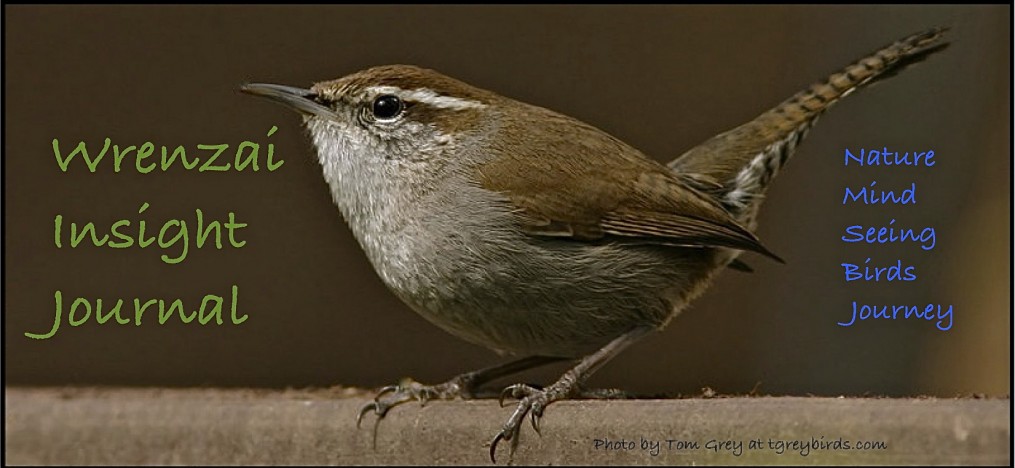Note: I wrote this essay two years ago for my college composition students to demonstrate use of multiple strategies in constructing an essay (narrative, description, compare-contrast, etc.). But in fact, by the time I posted it here, I’d gone mushroom hunting three times this fall without finding more than one or two of either species. After posting this essay, however, I went a fourth time, to a different spot, and found enough of each species for two scrambled egg breakfasts for two. Still scant in my area.
Recently I went mushrooming as I always do in the fall. Some years ago friends had us over for dinner for an introduction to mushrooming and mushroom preparation. Dave is an expert mushroomer who mushrooms all year round for all sorts of mushrooms, and Gail has taken it upon herself—under the circumstances—to learn to cook them. The occasion was a complete fall mushroom experience for us: We went out and found mushrooms and returned to their cabin to cook them using several recipes. Since then, I’ve become an enthusiastic fall mushroomer.
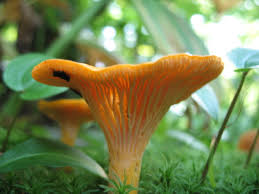
Ground-view chanterelle
Dave took us across the road from the cabin they often rent to a trail circling through the woods. He showed us two kinds of delicious edible mushrooms: the chanterelle and the hedgehog (not magic “shrooms”). These fungi tend to grow in similar habitats around the same time of year, from September to November—sometimes later, depending on the weather, region, and altitude. Both of these mushrooms prefer to grow under “virgin” evergreen trees, salal, and huckleberry, usually after the first heavy rains of fall. They don’t like to grow under deciduous trees; the falling leaves cover them and prevent them from springing up or cause them to rot beneath.
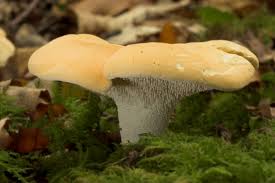
Ground-view hedgehog
The chanterelle, in its healthiest form, is a natural work of art. Yellowy-orange in color, the mushroom has gills that run down the stalk a ways. It’s heavy and dense, and sometimes the edges are frilled. It tends to grow in patches and can be found growing in the same spots every year, so it’s a good idea to memorize the landscape, down to the twig, for future mushrooming forays. The chanterelle is much sought after because it’s quite delicious and can be used in numerous recipes. It runs anywhere from $8 to $25 a pound in the supermarket when they’re available. In areas where it grows, buyers place the sign Mushroom Buyer in front of their homes or businesses, trying to draw pickers in to sell their mushrooms on the local market.
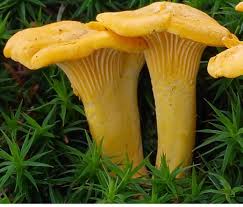
Note the color and how the gills run down to merge with the stalk.
The hedgehog is neither as popular nor as available in markets as the chanterelle, but it’s nearly as delicious as the chanterelle and sometimes more abundant. It consists of a white to pale brown irregularly shaped platform supported by a stiff white trunk. It likes to grow under salal and in sandier soil than the chanterelle, which prefers the rich wet peat directly under spruces and hemlocks. The hedgehog is fairly easily distinguished by the fact that, rather than having long striated gills running from the stalk out to the edge of the head on the underside, it instead has a type of gill that gives the mushroom its name: a soft white brush that resembles the bristles of a hedgehog. The mushroom can be quite stout and heavy, sometimes reaching two pounds in weight. It breaks more easily than the chanterelle, which is more sinewy and fibrous (and which itself can reach a pound or more), and the so-called “bristles” break loose and scatter in the frying pan, but both are tender to the palate.
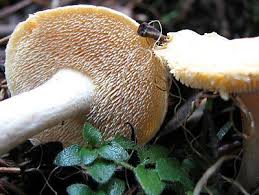
Note the soft hedgehog-like bristles instead of “gills.”
Many pickers carry a paper bag, a pocketknife, and a mushroom cleaning brush with them when they set out mushroom foraging. The paper bag keeps the mushrooms from becoming gooey. They use the knife to cut the stalk off at the ground in order not to harm the root system below. Keep in mind that the mushroom is merely the fruit of what is often a vast network of roots called a mycelium, which can live for centuries, conditions permitting. Mushroomers also use the knife, along with the brush, to do some preliminary cleaning before dropping a mushroom into the paper bag. One dirty mushroom can make a whole bag of mushrooms dirty, making for more cleaning work back home. It’s hard not to keep picking when the mushrooms are abundant. In fact, mushrooming, like other kinds of highfalutin foraging, can cause a gatherer to experience a kind of “gold fever.” Appropriately, both kinds of mushrooms can look golden in color, especially the chanterelle.
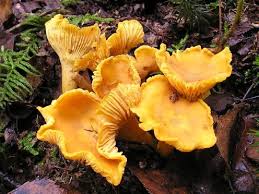
Free gold!
It’s no myth that mushroomers are secretive about and protective of privately discovered mushroom grounds. If the novice is lucky, a friend, relative, or professional mushroom hunter or mycologist will reveal or share an otherwise secret spot. More often than not, a mushroomer stumbles on a spot quite by accident. This was the case for me, when I discovered my second mushroom grounds. Shortly after our mushrooming lesson with Dave, my wife and I and a friend were walking in the woods when it occurred to me that I should keep an eye peeled for mushrooms. Sure enough, I found a single chanterelle under some salal beside an overgrown backwoods road, and I knew that where there was one there would be others. Before the day was done, we’d found several pounds of hedgehogs and several more chanterelles in the near vicinity of that first chanterelle. As far as I know, the three of us are the only ones who know about this spot, and I’m pretty sure our friend, who’s from Canada, could never find it again. As for my wife, she has no reason to return, because, in the fall, her husband regularly fetches home several pounds of the scrumptious creatures.
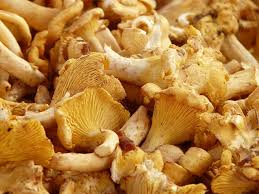
Pounds and pounds to saute and freeze….
When I arrived at my secret spot this afternoon, I felt dubious about whether I’d find any mushrooms at all. It’s been an off year. We had 75 days of dry weather starting in August, taking us deep into fall without rain, which makes for terrible conditions for mushrooms, who need a good “spill” to “blossom” (which they can do overnight). When I went there two weeks earlier, I found a mere pound of chanterelles—and no hedgehogs. Typically, I find about four pounds, and maybe another two pounds later—a mix of the two species. And most of the mushrooms I found two weeks earlier were soggy. Some had white mold on their gills; these I threw away, not wanting to risk an accidental psychedelic journey.
I heard on the radio that it’s been a universally bad year for mushrooms in the Northwest and that restaurants are desperate for a supply in order to keep favorite menu items available to customers, a fact that points to just how popular wild mushrooms are and how obsessive the connoisseur can be about eating them. In fact, our friend Dave eats them as if his life depended on them. He believes that mushrooms have health-enhancing, life-extending powers, and now that he’s bought into that belief, there’s no stopping eating them now.
So, as I ducked into the woods this afternoon and up along a bank where the deer traverse and leave droppings in abundance, I didn’t expect to find any more mushrooms, at least not chanterelles. The alder leaves had already fallen and no doubt smothered those few mushrooms that never saw the light of day or had rotted those few that had. Yet, as I’d scrambled under and over and around rain-wet bushes and branches, wending my way along crisscrossing deer paths, I spotted that familiar orange color that stands out even against the yellow of fallen alder leaves. By the time I’d walked my usual route, I’d found another pound of chanterelles, many, again, gooey with rain and leaves. My hope is that the hedgehogs will make an appearance later in the month, once we have some colder, dryer nights.
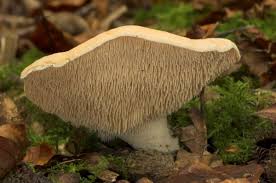
Ah, the perfect hedgehog!
As soon as I got home with my skimpy pickings, I poured the mushrooms out on a large cutting board. I used a knife tip and a dry brush to remove bits of leaf, spruce needles, peat, and sand. For the first time in my fall mushrooming career, I used the kitchen tap to clean some of the gooier mushrooms. They were so wet already that it didn’t matter. However, expert mushroomers prefer to dry-clean these—if not all—species of mushrooms. What’s great about finding only a few mushrooms is that it takes only about ten or fifteen minutes to clean them, whereas it might take an hour to clean four pounds.
Just enough mushrooms for scrambled eggs in the morning, I thought, as I placed the cleaned mushrooms in a new dry bag and then in the refrigerator for the next morning’s meal. Fry them up for scrambled eggs, make them the meaty heart of a thick soup, sauté them for either a white or red pasta sauce, or dice them fine to mix into rice. The flavor of both hedgehogs and chanterelles far exceeds that of the standard issue grocery store mushroom.
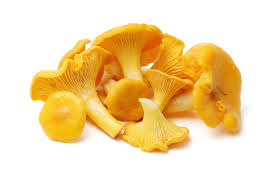
Just enough for scrambled eggs….
The sensation of finding, cleaning, stashing away in the refrigerator, or sautéing and freezing such valuable natural gifts as wild mushrooms is deeply satisfying. We don’t even need a license to pick wild mushrooms! But watch out about mushrooming on private property or even public property already staked out by possessive mushroomers. Stories abound about shotguns going off and a few pellets piercing the unsuspecting rear end of an overly enthusiastic fungus gatherer.
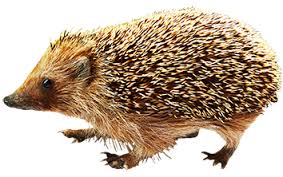
Will the real hedgehog please rise?
